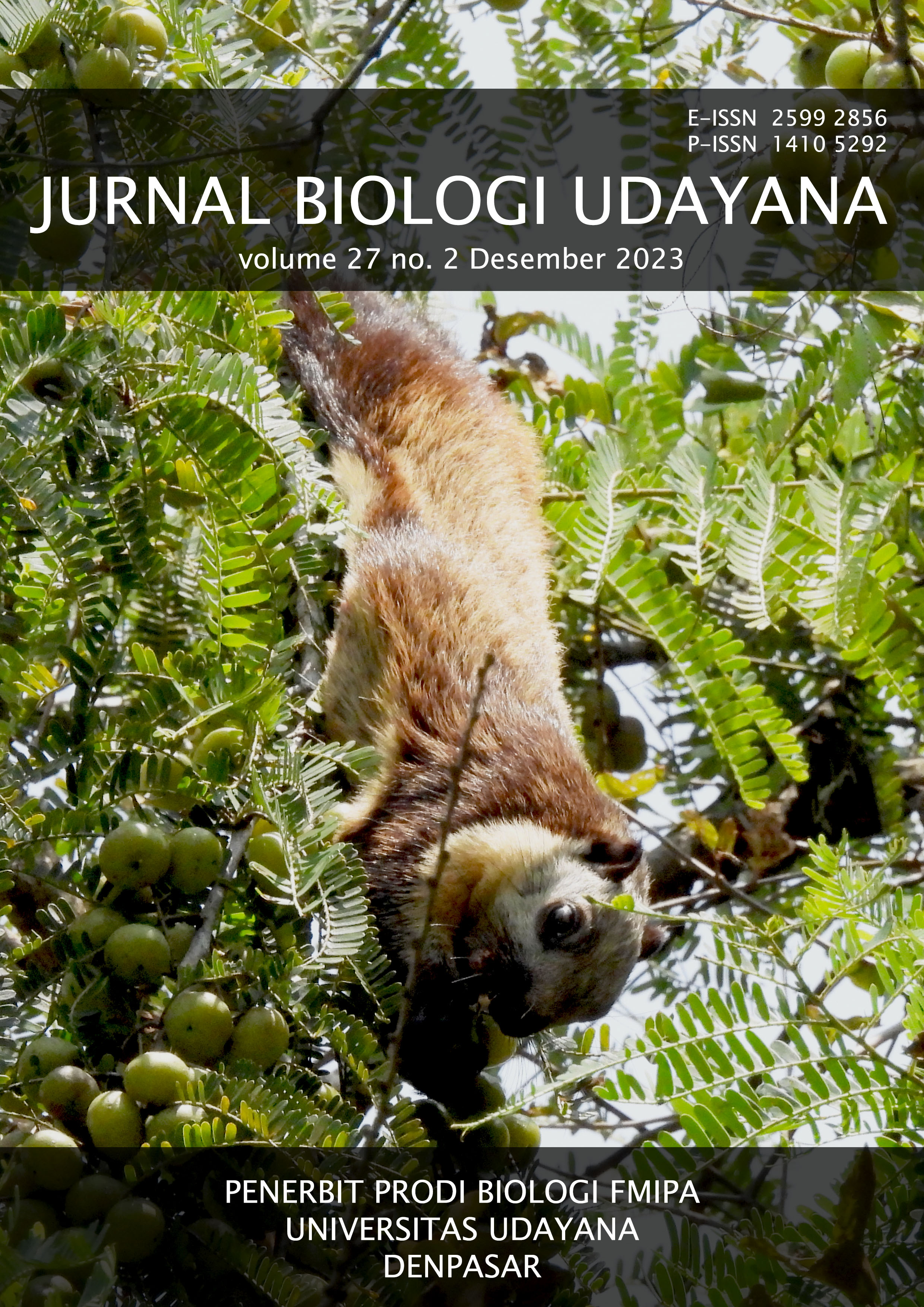Pengaruh bentuk morfologi bunga tanaman refugia terhadap ketertarikan serangga polinator dan musuh alami Ordo Hymenoptera
Abstract
Tanaman refugia merupakan jenis tumbuhan berbunga yang berfungsi menyediakan tempat berlindung dan sumber makanan bagi serangga musuh alami dan polinator. Jumlah serangga musuh alami dan polinator yang berkunjung ke tanaman adanya faktor perbedaan karakter morfologi, warna bunga, nektar, lama waktu berbunga dan aroma. Serangga menyukai bunga yang berukuran kecil, bentuk kelopak yang terbuka, letak polen di luar karena mudah di jangkau dan juga waktu berbunga yang lebih lama. Penelitian ini dilakukan di lahan Kalisat dan di Laboratorium Agroteknologi Universitas Jember pada 1 Januari hingga 30 Desember 2022. Penelitian ini menggunakana Rancangan Acak Kelompok(RAK) dengan4 ulangan dan 8 perlakuan jenis bunga yaitu Cosmos caudatus, Zinna elegans, Melampodium divaricatum, Tegestes erecta, Cucumis sativus L., Bassica rapa, Solanum melongena L., Lycopersicum esculentum Mill. Hasil penelitian menunjukkan presentase M. divaricatum menghasilkan persentase serangga parasitoid dari familia Chalcidade sebesar 17% dan Braconidae 16?. Pada bunga C. sebagian besar yang berkunjung serangga parasitoid dari familia Braconidae 18%. Pada bunga Zinnia sp kunjungan serangga parasitoid dari familia Pompilidae 19%. Bunga T. erecta yang berkunjung serangga polinator dari familly Apidae 23%. Pada jenis bunga hortikultura yaitu C. sativus terbesar pada serangga predator familly Ampulicidae 25%, sedangkan pada bunga B. rapa familly Barconidae 39%, S. melongena L. Ichenumonidae dan Braconidar 33%, L. esculentum Mill. Icneumonidae sebesar 38% serangga tersebut sebagai parasitoid. Perlakuan Terbaik pada bunga M. divaricatum dengan tipe jenis bunga terbuka, letak polen di luar,diameter mahkota 23,44 mm , diameter dasar 11,48 mm, panjang tabung bunga 5,22,mm lama waktu berbunga 24,25 hari.
Downloads
References
Erdiansyah, I., D.R.K. Ningrum, dan Damanhuri. 2018. Pemanfaatan Tanaman Bunga Marigold dan Kacang Hias terhadap Populasi Athropoda pada Tanaman Padi Sawah. Applied Agricultural Sciences, 2(2) : 117-125.
Gembong, Tjitrosoepomo. 2016. Morfologi Tumbuhan. Yogyakarta : Gadjah Mada University Press.
Ifanalia, Musbihatun., Wiwik, Sri,H., & Wiwin, Windriyanti. 2021. Keberadaan Serangga Musuh Alami dan Penyerbuk Pada Pertanaman Jeruk Pamelo (Citrus maxima (Burm) Merr.) Manipulasi Habitat Dengan Tanaman Refugia. Prosiding Seminar Nasional Agroteknologi. 68-73.
Karenina, Tili., S, Herlinda., Chandra Irsan.,& Yulia Pujiastuti. 2020. Arboreal Entomophagous Arthropods of Rice Insect Pests Inhabiting Adaptive Vegetables and Refugia in Freshwater Swamps of South Sunatra. AGRIVITA Journal of Agricultural Science. 42(2): 214–228
Nupi, Massimo., Donato, A, Grasso., & Stefano, Mancuso. 2018. Nectar in Plant Insect Mutualistic Relationship : From Food Reward to Partner Manipulation. Frontiers In Plant Science. 9 (1063): 1-14.
Pratama., Ni, Luh, W, & I, Ketut. 2018. Perbedaan Ketinggian Tempat Terhadap Jenis Polen Yang Dikoleksi oleh Lebah Trigona. Jurnal Biologi Udayana. 22(1): 44-48.
Purwatingsih, Budi. 2014. Serangga Polinator. Malang: Universitas Brawijaya Press.
Risaldi, Semharinto., Soedijo., & Salamiah. 2021. Keanekaragaman Arthopoda dan Kelimpahan Musuh Alami pada Empat Jenis Tanaman Refugia. Proteksi Tanaman Tropika. 4(02) : 320-329.
Sumini., & S, Bahri. 2020. Keanekaragaman dan Kelimpahan Musuh Alami di ditanaman Padi Berdasarkan Jarak Dengan Tanaman Refugia. Jurnal Agrotek Tropika. 8(1): 177-184.
Tuell, Juliana, K., Anna, K, Fiedler., & Rufus, Isaacs. 2008. Visitation by Wild and Managed Bees (Hymenoptera: Apoidea) to Eastern U.S. Native Plants for Use in Conservation Programs.Enviromental Entomology. 37(3): 707-718.
Vicens, Narci., & Jordi, Boschi. 2000. Pollinating Efficacy of Osmia cornuta and Apis mellifera (Hymenoptera: Megachilidae, Apidae) on ‘Red Delicious’ Apple. Environmental Entomology. 29(2): 235-240.
Wahidah, F.F., G. Mudjiono, dan S. Karindah. 2015. Pengaruh Zea mays L. dan Tagetes erecta L. sebagai Tanaman Perangkap Terhadap Populasi Helicoverpa armigera Hubn. (Lepidoptera: Noctuidae) pada Tomat Organik. HPT, 3(3): 72-78.
Weackers, F, L. 2004. Assessing the Suitability of Flowering Herbs as Parasitoid Food Sources: Flower Attractiveness and Nectar Accessibility. Biological Control .29 : 307–314.





